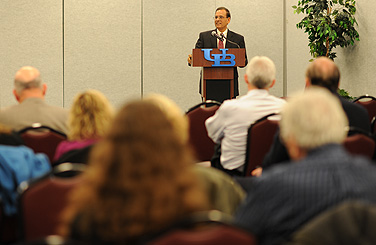News
Faculty key to rising in AAU,
Tripathi tells voting faculty

President Satish K. Tripathi’s first address to the voting faculty focused on how UB plans to rise in the ranks of AAU institutions. Photo: NANCY J. PARISI
Thanks to the passage of NY SUNY 2020, UB now may focus on investing resources—including hiring hundreds of additional faculty members—that will allow it to realize its goal of moving up in the ranks of AAU institutions, President Satish K. Tripathi told UB faculty members on Tuesday.
In his first formal address to UB’s voting faculty, Tripathi said the funding UB will receive from the five-year tuition model authorized by NY SUNY 2020 will allow the university for the first time to plan on a “five-year horizon.” And while there are no guarantees, he said, “it looks like we won’t have to keep cutting (the budget) ever year.”
Tripathi stressed that faculty are critical to the quality of an institution and key to UB’s efforts to move into the next tier of AAU institutions.
“If you look at any institution, faculty members are the critical part of the quality of the institution,” he said.
He cited some key performance indicators that, he said, determine “the quality of an institution from the AAU’s viewpoint.” Among them are competitive, federally funded research support for faculty; faculty membership in the national academies; citations of faculty publications in prestigious, peer-reviewed journals; and other faculty awards, fellowships and memberships.
Tripathi said that if he had to sum up the AAU measures, he would say that “all they care about is research, or scholarship.”
“The basic hypothesis is that the stronger the scholarship and research, the more impact you have.”
So, increasing the number of faculty members—UB plans to create 300 new faculty positions over the next five years, including 100 additional endowed chairs—and improving the quality of those hires, as well as the amount and quality of scholarship and research, are important to moving up in the AAU, he said.
Important as well is the quality of the students who attend UB, and the quality of the education provided to those students, he said, noting that student selectivity and six-year graduation rates also are among the AAU performance measures.
He said that Scott Weber, vice provost for undergraduate education, is working on a four-year graduation guarantee for undergraduates.
And the university continues to work to improve the living and learning environment for students, citing the opening of Greiner Hall and the ongoing classroom renovation project that has upgraded—both technologically and aesthetically—an average of 11 classrooms a year for the past three years at an annual average cost of $2.2 million.
Moreover, UB’s commitment to invest 25 percent of the increased tuition revenues into need-based financial aid and its plan to raise $200 million for student scholarships will increase access and make the university more affordable for students, he said.
While resources from NY SUNY 2020 can be used to hire faculty and improve infrastructure, “in order for us to recruit the faculty that we want, in order for us to recruit the students that we want, we need extra money from outside,” he said, citing as the top objectives raising money for the 100 endowed chairs and $200 million for student scholarships.
Tripathi noted he is spending “more time on the road,” meeting with UB alumni and supporters in an effort to raise additional resources. The first leg of his “20 cities in 20 months” tour was spent in Atlanta and Knoxville, Tenn., he said.
“My goal is to continue to work so that we can provide resources,” he said. “We are on our way in that direction.”
Tripathi also reported that more than 100 proposals—half of which are multidisciplinary—have come in from across the campuses seeking funding through the “3 E fund,” a fund financed with tuition revenues and named after Tripathi’s three areas of focus: excellence, efficiency and engagement.
The proposals will be reviewed by a panel of nine—three faculty members, three former administrators, who are assumed to have no vested interests, and three staff members. Tripathi and Provost Harvey Stenger Jr. will determine which of the recommended projects will receive funding.
“This is the only way, in my opinion—selective investment, faculty investment, quality of education and research—these are the only things we can do to improve the institution,” Tripathi said.
Despite the recent budget cuts and financial challenges, UB has been able to maintain its core—its faculty and students, Tripathi told faculty members.
As for the future, “It’s very simple because it’s really in our hands,” he said.

Reader Comments
Jibreel Riley says:
this is great like Kellogg frosted flakes now if we can only get into a real Athletic Conference with like minded universities we would be golden!
Posted by Jibreel Riley, undergrad , 11/03/11